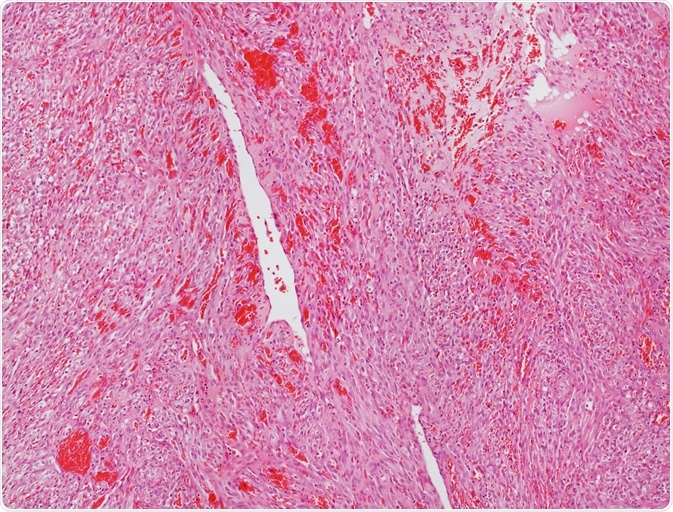Sarcomas are soft tissue tumors that can develop in any part of the body. The term “sarcoma” has a Greek origin, which means “fleshy growth.” This category of tumors consists of more than 70 subtypes, which are classified on the basis of two factors—the tissue of origin and chromosomal abnormalities. Each of these has its own unique features.
Angiosarcoma is a type of soft tissue tumor that originates from the vascular endothelial cells which form the inner lining of blood as well as lymphatic vessels. This sarcoma is rare, but malignant in nature and affects any part of the body, especially, the skin, liver, breast, and deep tissues.
 Microscope picture of an angiosarcoma. Image Credit: Convit / Shutterstock.com
Microscope picture of an angiosarcoma. Image Credit: Convit / Shutterstock.com
Characteristics of angiosarcoma
Angiosarcoma is aggressive and sometimes recurs after treatment in the same place of initial onset. This characteristic of the disease is known as local recurrence.
Metastasis or secondary cancer is another property of this tumor by which it tends to spread widely to other parts of the body. Lungs, liver, brain, etc., are the parts where this secondary occurrence happens.
The mortality rate owing to this disease is very high due to its misdiagnosis or poor diagnosis and the difficulty associated with treating it. In addition, angiosarcoma is multicentric; this characteristic of this tumor makes therapeutic options more complicated.
Classification of angiosarcomas
- Angiosarcoma can be either primary or secondary based on its occurrence. If a person who never had cancer before is affected by angiosarcoma, he/she is said to have primary angiosarcoma, whereas if a tumor arises in the part which has already been affected by cancer and where radiation treatment has been given, it is secondary angiosarcoma.
- Angiosarcoma is also classified based on the place of origin. Hemangiosarcoma is a type of angiosarcoma that originates in the walls of blood vessels, whereas lymphangiosarcoma is a type which originates in the lymph vessels. The tumor that starts in the soft tissues or some internal organs, such as the lungs or the liver, is termed as hemangioendothelioma.
- The place of occurrence of angiosarcoma is another factor that is taken into consideration while classifying this disease. Based on this, there are different types of angiosarcomas:
- Epithelioid angiosarcoma: This rare type of angiosarcoma occurs in the endothelial cells which form the lining on the interior surface of the blood vessels.
- Hepatic angiosarcoma: This is an aggressive and fatal tumor that infects the blood vessels inside the liver.
- Cardiac angiosarcoma: This is a tumor of the endothelial cells of the heart. 90% of this rare cancer affects the right atrium. It is aggressive in nature, spreading to the nearby myocardial wall and then to the atrial chamber, the vena cava, as well as the tricuspid valve.
- Cutaneous angiosarcoma: This is an angiosarcoma that affects the skin’s blood vessels. Manifestations of this disease include other kinds of skin diseases with which it often get misdiagnosed. In most of the cases, it is seen in scalp and face. It often responds poorly to treatments and the condition deteriorates fast. When this angiosarcoma arises below the skin surface, it is termed as subcutaneous angiosarcoma. Cutaneous angiosarcoma may or may not occur in association with lymphedema. The one that lacks association is the most common type of cutaneous angiosarcoma.
- Breast angiosarcoma: This kind of angiosarcoma usually affects women who have undergone treatments like surgery and radiotherapy for breast cancer. Breast angiosarcoma is more aggressive than common breast cancers and has the tendency to grow rapidly, making it difficult to treat. Primary breast angiosarcoma normally occurs in the third to fourth decade of women's life. It causes enlargement of the breast and change of color of the breast to blue-red. Even though it affects deep soft tissues, it does not spread to the muscles of the chest wall.
- Soft tissue angiosarcoma: It affects the soft tissues of both men and women equally at any age. In extreme cases, it is manifested either in the mass in the affected part or as compression of structures inside the abdomen. An increased size of the tumor, in this case, can be associated with damage to the platelets, failure of the heart, and spontaneous bleeding; this occurs mostly in young people. Owing to the difficulty in distinguishing angiosarcoma of the soft tissue from other types of tumors, its diagnosis becomes difficult. Organ-specific angiosarcomas, such as angiosarcoma of the heart and lungs, are subtypes of this category. Even though the basic principle is the same for all cases, the treatments employed are individualized in nature.
- Bone angiosarcoma: This type of tumor is rare but very malignant, mostly affecting people who are 50–70 years old. Bones in the skeleton, which includes the rib cage, skull, and spine, which are long, as well as tubular, are the areas where it occurs. There is a chance of recurrence after long gaps.
Angiosarcoma: 5-Minute Pathology Pearls
References
Further Reading